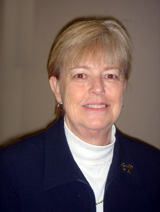Educational and School Change
March 22, 2012, The IRIS Center
Pearl Sims discusses some of the issues related to educational leadership, addressing both the qualities of leadership and the implementation of school change (time: 4:49).
Questions asked of Pearl Sims in this audio:
- Dr. Sims, can you talk about some of the differences between managing and leading?
- And what about implementing change in a school? Can you discuss some of the issues involved in that process?

Pearl Sims, PhD
Director, Leadership Development Center
Vanderbilt University
Transcript: Pearl Sims, PhD
Pearl Sims discusses some of the issues related to educational leadership, addressing both the qualities of leadership and the implementation of school change (time: 4:49).
Narrator: Pearl Sims is a nationally recognized expert in the field of educational and organizational leadership. She is the director of the Leadership Development Center at Peabody College, Vanderbilt University. She is a national facilitator for Microsoft’s Partners in Learning and has directed Peabody College’s highly successful Principals’ Leadership Academy.
Narrator: Dr. Sims, can you talk about some of the differences between managing and leading?
Pearl Sims: I think so often the difference between managing and leading is, instead of doing it for people, you’re doing it with them. Often in management, I’m doing the kinds of actions it takes to manage the building. Where leadership begins to happen is when you’re able to really transfer information to wisdom through action. All this information comes at you, but what pieces of this information do we really need if we’re going to truly impact our students? And we know that we’ve got to bring people along in reacting wisely to that new information in terms of what it really means to our students and to our community. It’s one thing for me to dictate that; it’s something else for me to say, “Lets discuss what this means to us and to our students.” What does this really means in terms of the choices we have in front of us and then what do I do to help you act on that choice? Not do it for you, not dictate it, but to give you the will and the heart to help me help this happen now that we’ve collectively decided this is the right choice. And then we know that we have to be able to actually do something about this, implement it well. There’s an old saying about leadership that a really good leader always staffs to their weakness. We tend to think that leaders ought to know it all, they ought to be above mistakes, they ought to be above learning, and yet we’re living in a time when leaders have to, first and foremost, model learning. We’re living in a period of time when no leader can know everything there is to know. And am I willing to be vulnerable enough during that learning process to let others see that I’m not embarrassed by my lack of knowledge? And, bottom line, that it’s about courage: It’s courage to look at myself, know myself, know what I do well and know what I don’t do well, and care enough about the mission, in this case about children, really being able to learn enough to lay all that pride down for the sake of our children.
Narrator: And what about implementing change in a school? Can you discuss some of the issues involved in that process?
Pearl Sims: I just absolutely believe that all strong, significant, lasting change is incremental. It doesn’t make much sense to try to scale change before you know it works. I actually believe strongly, and we encourage the principals we train to really think of things as a prototype, a prototype with those people who are willing to go first helps you know if what we’re thinking is going to work, it helps you work out the bugs as you try to “scale it.” But it also gets those early adopters who really want to be engaged in this thing really thinking about it, and what you’ll usually see is this informal law of thirds, where you have about 1/3 who will lead, 1/3 that will follow, and 1/3 that you’re just going to have to figure it out. So you’ve got these people who can lead going ahead and doing it and then what you find is that there is going to be this next ring of people who went, “Well, that wasn’t so bad after all, and this will work,” and you slowly begin. I think so often what we fail to do is to have something where we say to people who may be the naysayers or those that are more reluctant to join, “Come and see.” Invite those people who are going to go, “oh,” then come see what we’re doing over here because seeing is believing. So often what happens with change is people get pretty cynical pretty quickly: Oh nothing ever’s going to change. Or they don’t know. They’re not conceptual. They really are concrete thinkers, and that’s okay. So they need to be able to see what you’re talking about.
Narrator: Thank you for listening to this episode of the IRIS Center podcast. For more information about the IRIS Center and its resources, visit us at www.iriscenter.com [https://iris.peabody.vanderbilt.edu/].